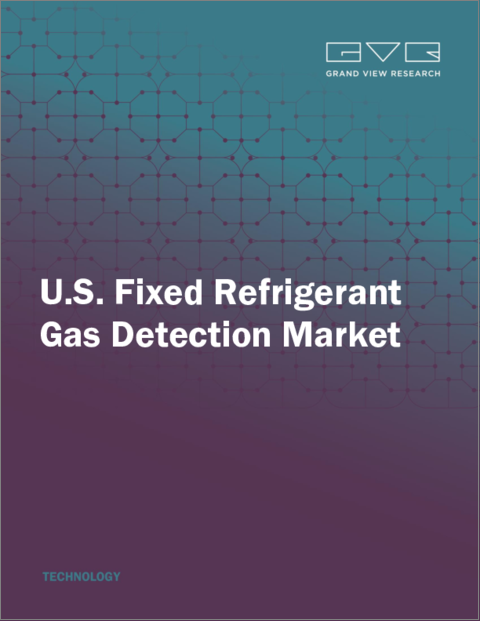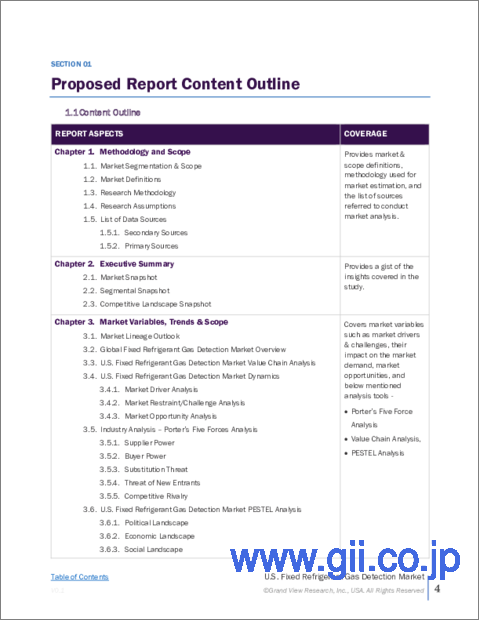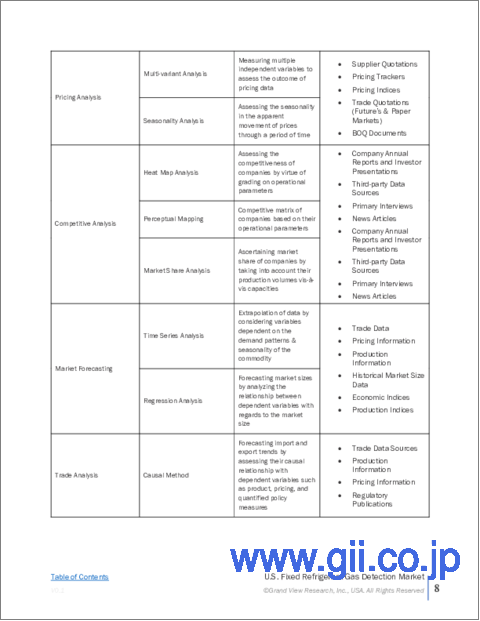|
|
市場調査レポート
商品コード
1751213
米国の固定式冷媒ガス検知の市場規模、シェア、動向分析レポート:製品タイプ別、冷媒タイプ別、最終用途別、セグメント予測、2025年~2030年U.S. Fixed Refrigerant Gas Detection Market Size, Share & Trends Analysis Report By Product Type (Infrared Gas Detectors, Semiconductors gas Detectors), By Refrigerant Type, By End-use, And Segment Forecasts, 2025 - 2030 |
||||||
カスタマイズ可能
|
|||||||
| 米国の固定式冷媒ガス検知の市場規模、シェア、動向分析レポート:製品タイプ別、冷媒タイプ別、最終用途別、セグメント予測、2025年~2030年 |
|
出版日: 2025年05月02日
発行: Grand View Research
ページ情報: 英文 120 Pages
納期: 2~10営業日
|
全表示
- 概要
- 図表
- 目次
市場規模と動向:
米国の固定式冷媒ガス検知市場規模は2024年に8,620万米ドルと推計され、2025年から2030年にかけてCAGR 7.1%で成長すると予測されています。
冷媒排出に関する環境規制が厳しくなっていることが、米国の固定式冷媒ガス検知市場の成長に寄与しています。米国の固定式冷媒ガス検知業界は、CO2、アンモニア、炭化水素といった環境に優しい冷媒への移行に大きな影響を受けています。連邦政府や州レベルの規制がハイドロフルオロカーボン(HFC)やハイドロクロロフルオロカーボン(HCFC)の排出削減を推進する中、各業界で低GWP冷媒の採用が進んでいます。特にCO2の使用量の増加は、その環境負荷の低さに後押しされ、コンプライアンスと安全性を確保するために、業務用冷凍機に固定式検知器を設置することを促しています。
米国全域で業務用冷蔵インフラの設置面積が拡大していることが、固定式冷媒ガス検知器の需要を押し上げています。スーパーマーケットチェーン、食料品店、冷蔵倉庫の拡大に伴い、冷媒漏れを防ぐための信頼性の高い監視システムの必要性はかつてないほど高まっています。これらのシステムは在庫を保護し、一貫した環境条件とエネルギー効率の維持に役立ちます。自動化、漏れ検知、リアルタイムアラートを組み合わせた統合ソリューションを企業が求める中、スマート冷凍技術の採用がこの動向をさらに加速させています。
スマート技術の統合は、米国の固定式冷媒ガス検知業界の情勢を変えつつあります。最新の固定式検知システムは、IoT接続を装備するようになってきており、リアルタイムのモニタリング、リモートアクセス、自動アラートを可能にしています。これらの進歩により、施設管理者はより効率的に漏れを検知し対応することができ、ダウンタイムとメンテナンスコストを削減することができます。さらに、スマートディテクターは予知保全戦略をサポートし、クラウドベースのデータロギングを提供することで、企業がコンプライアンス要件を満たし、実用的な洞察を通じて冷凍システムのパフォーマンスを最適化するのを支援します。
米国のヘルスケアおよび製薬セクターは、固定式冷媒ガス検知業界の重要な牽引役として台頭しています。病院、研究所、医薬品製造施設は、ワクチン保管、化学薬品保存、医療機器操作など、気候の影響を受けやすいプロセスにおいて、冷凍システムに大きく依存しています。そのため、冷媒の漏れは患者の安全と製品の完全性に重大なリスクをもたらします。厳格な規制基準と品質保証プロトコルが導入されているため、これらの分野では、中断のないコンプライアントで安全なオペレーションを確保するために固定式ガス検知システムの設置が優先されており、米国の固定式冷媒ガス検知市場の成長を牽引しています。
しかし、初期投資やメンテナンスコストが高いなどの要因が、米国の固定式冷媒ガス検知市場の成長を妨げる可能性があります。固定式冷媒ガス検知システムを導入するには、センサーの設置、校正、既存のHVACシステムや安全システムとの統合など、多額の初期投資が必要となります。これらのコストは、厳しい予算で運営されることが多い中小企業(SME)にとって特に負担となる可能性があります。設置だけでなく、定期的なメンテナンス、センサーの再校正、定期的な交換も継続的な出費の原因となり、長期的な総所有コストを増加させます。
目次
第1章 調査手法と範囲
第2章 エグゼクティブサマリー
第3章 米国の固定式冷媒ガス検知市場の変数、動向、範囲
- 市場系統の見通し
- 市場力学
- 市場促進要因分析
- 市場抑制要因分析
- 業界の課題
- 米国の固定式冷媒ガス検知市場分析ツール
- 業界分析- ポーターのファイブフォース分析
- PESTEL分析
第4章 米国の固定式冷媒ガス検知市場:製品タイプ別 推定・動向分析
- セグメントダッシュボード
- 米国の固定式冷媒ガス検知市場:製品タイプ別変動分析、2024年および2030年
- 赤外線ガス検知器
- 電気化学式ガス検知器
- 半導体ガス検知器
- その他
第5章 米国の固定式冷媒ガス検知市場:冷媒の種類別 推定・動向分析
- セグメントダッシュボード
- 米国の固定式冷媒ガス検知市場:冷媒の種類別変動分析、2024年および2030年
- ハイドロフルオロカーボン(HFC)
- ハイドロクロロフルオロカーボン(HCFC)
- アンモニア(NH3)
- 二酸化炭素(CO2)
- 炭化水素
- その他
第6章 米国の固定式冷媒ガス検知市場:最終用途別 推定・動向分析
- セグメントダッシュボード
- 米国の固定式冷媒ガス検知市場:最終用途別変動分析、2024年および2030年
- 産業用
- 商業用
- 商業収益の推定と予測、2018年~2030年
- 住宅
- ヘルスケアと医薬品
第7章 競合情勢
- 企業分類
- 企業の市場ポジショニング
- 企業ヒートマップ分析
- 企業プロファイル/上場企業
- Honeywell International Inc.
- MSA
- CAREL INDUSTRIES SpA
- SAMON AB
- Calibration Technologies, LLC.
- RC Systems, Inc.
- Danfoss
- Emerson Electric Co.
- INFICON
- NevadaNano
List of Tables
- Table 1 U.S. fixed refrigerant gas detection market revenue estimates and forecast, by product type, 2018 - 2030 (USD Million)
- Table 2 U.S. fixed refrigerant gas detection market revenue estimates and forecast, by refrigerant type, 2018 - 2030 (USD Million)
- Table 3 U.S. fixed refrigerant gas detection market revenue estimates and forecast, by end use, 2018 - 2030 (USD Million)
- Table 4 Company heat map analysis
- Table 5 Key companies involved in M&As
- Table 6 Key companies pursuing partnerships & collaborations
- Table 7 Key companies focusing on new product/service launches
List of Figures
- Fig. 1 U.S. Fixed Refrigerant Gas Detection market segmentation
- Fig. 2 Market research process
- Fig. 3 Information procurement
- Fig. 4 Primary research pattern
- Fig. 5 Market research approaches
- Fig. 6 Value chain-based sizing & forecasting
- Fig. 7 Parent market analysis
- Fig. 8 Market formulation & validation
- Fig. 9 U.S. Fixed Refrigerant Gas Detection market snapshot
- Fig. 10 U.S. Fixed Refrigerant Gas Detection market segment snapshot
- Fig. 11 U.S. Fixed Refrigerant Gas Detection market competitive landscape snapshot
- Fig. 12 Market research process
- Fig. 13 Market driver relevance analysis (Current & future impact)
- Fig. 14 Market restraint relevance analysis (Current & future impact)
- Fig. 15 U.S. Fixed Refrigerant Gas Detection market, Product Type outlook key takeaways (USD Million)
- Fig. 16 U.S. Fixed Refrigerant Gas Detection market, Product Type movement analysis 2024 & 2030 (USD Million)
- Fig. 17 Infrared Gas Detectors market revenue estimates and forecasts, 2018 - 2030 (USD Million)
- Fig. 18 Electrochemical Gas Detectors market revenue estimates and forecasts, 2018 - 2030 (USD Million)
- Fig. 19 Semiconductor Gas Detectors market revenue estimates and forecasts, 2018 - 2030 (USD Million)
- Fig. 20 Others market revenue estimates and forecasts, 2018 - 2030 (USD Million)
- Fig. 21 U.S. Fixed Refrigerant Gas Detection market: Refrigerant Type outlook key takeaways (USD Million)
- Fig. 22 U.S. Fixed Refrigerant Gas Detection market: Refrigerant Type movement analysis 2024 & 2030 (USD Million)
- Fig. 23 Hydrofluorocarbons (HFCs) market revenue estimates and forecasts, 2018 - 2030 (USD Million)
- Fig. 24 Hydrochlorofluorocarbons (HCFCs) market revenue estimates and forecasts, 2018 - 2030 (USD Million)
- Fig. 25 Ammonia (NH3) market revenue estimates and forecasts, 2018 - 2030 (USD Million)
- Fig. 26 Carbon Dioxide (CO2) market revenue estimates and forecasts, 2018 - 2030 (USD Million)
- Fig. 27 Hydrocarbons market revenue estimates and forecasts, 2018 - 2030 (USD Million)
- Fig. 28 Others market revenue estimates and forecasts, 2018 - 2030 (USD Million)
- Fig. 29 U.S. Fixed Refrigerant Gas Detection market: End Use outlook key takeaways (USD Million)
- Fig. 30 U.S. Fixed Refrigerant Gas Detection market: End Use movement analysis 2024 & 2030 (USD Million)
- Fig. 31 Industrial revenue estimates and forecasts, 2018 - 2030 (USD Million)
- Fig. 32 Commercial market revenue estimates and forecasts, 2018 - 2030 (USD Million)
- Fig. 33 Residential market revenue estimates and forecasts, 2018 - 2030 (USD Million)
- Fig. 34 Healthcare & Pharmaceuticals market revenue estimates and forecasts, 2018 - 2030 (USD Million)
- Fig. 35 Strategy framework
- Fig. 36 Company Categorization
Market Size & Trends:
The U.S. fixed refrigerant gas detection market size was estimated at USD 86.2 million in 2024 and is projected to grow at a CAGR of 7.1% from 2025 to 2030. Growing stringent environmental regulations on refrigerant emissions can be attributed to the growth of the U.S. fixed refrigerant gas detection market. The U.S. fixed refrigerant gas detection industry is significantly influenced by the transition toward environmentally friendly refrigerants such as CO2, ammonia, and hydrocarbons. As federal and state-level regulations push for the reduction of hydrofluorocarbon (HFC) and Hydrochlorofluorocarbons (HCFCs) emissions, businesses across industries are adopting low-GWP refrigerants. The increased usage of CO2, in particular driven by its low environmental impact, is prompting the installation of fixed detectors in commercial refrigeration to ensure compliance and safety.
The growing footprint of commercial refrigeration infrastructure across the U.S. is boosting demand for fixed refrigerant gas detectors. With the expansion of supermarket chains, grocery outlets, and cold storage facilities, the need for reliable monitoring systems to prevent refrigerant leaks has never been greater. These systems protect inventory and help maintain consistent environmental conditions and energy efficiency. The adoption of smart refrigeration technologies is further accelerating this trend, as businesses seek integrated solutions that combine automation, leak detection, and real-time alerts.
Smart technology integration is transforming the U.S. fixed refrigerant gas detection industry landscape. Modern fixed detection systems are increasingly equipped with IoT connectivity, allowing for real-time monitoring, remote access, and automated alerts. These advancements enable facility managers to detect and respond to leaks more efficiently, reducing downtime and maintenance costs. Furthermore, smart detectors support predictive maintenance strategies and offer cloud-based data logging, helping businesses meet compliance requirements and optimize their refrigeration system performance through actionable insights.
The healthcare and pharmaceutical sectors in the U.S. are emerging as important drivers of the fixed refrigerant gas detection industry. Hospitals, laboratories, and pharmaceutical manufacturing facilities rely heavily on refrigeration systems for climate-sensitive processes, including vaccine storage, chemical preservation, and medical equipment operation. As a result, any refrigerant leak poses significant risks to patient safety and product integrity. With strict regulatory standards and quality assurance protocols in place, these sectors are prioritizing the installation of fixed gas detection systems to ensure uninterrupted, compliant, and safe operations, thereby driving the U.S. fixed refrigerant gas detection market growth.
However, factors such as high initial investment and maintenance costs could hamper the growth of the U.S. fixed refrigerant gas detection market. Implementing fixed refrigerant gas detection systems requires a significant upfront investment, encompassing sensor installation, calibration, and integration with existing HVAC and safety systems. These costs can be particularly burdensome for small and medium-sized enterprises (SMEs), which often operate on tighter budgets. Beyond installation, regular maintenance, sensor recalibration, and periodic replacements further contribute to ongoing expenses, increasing the total cost of ownership over time.
U.S. Fixed Refrigerant Gas Detection Market Report Segmentation
This report forecasts revenue growth at a country level and provides an analysis of the latest industry trends in each of the sub-segments from 2018 to 2030. For this study, Grand View Research has segmented the U.S. fixed refrigerant gas detection market report based on product type, refrigerant type, and end-use:
- Product Type Outlook (Revenue, USD Million, 2018 - 2030)
- Infrared Gas Detectors
- Electrochemical Gas Detectors
- Semiconductor Gas Detectors
- Others
- Refrigerant Type Outlook (Revenue, USD Million, 2018 - 2030)
- Hydrofluorocarbons (HFCs)
- Hydrochlorofluorocarbons (HCFCs)
- Ammonia (NH3)
- Carbon Dioxide (CO2)
- Hydrocarbons
- Others
- End-use Outlook (Revenue, USD Million, 2018 - 2030)
- Industrial
- Commercial
- Residential
- Healthcare & Pharmaceuticals
Table of Contents
Chapter 1. Methodology and Scope
- 1.1. Market Segmentation and Scope
- 1.2. Research Methodology
- 1.2.1. Information Procurement
- 1.3. Information or Data Analysis
- 1.4. Methodology
- 1.5. Research Scope and Assumptions
- 1.6. Market Formulation & Validation
- 1.7. Country Based Segment Share Calculation
- 1.8. List of Data Sources
Chapter 2. Executive Summary
- 2.1. Market Outlook
- 2.2. Segment Outlook
- 2.3. Competitive Insights
Chapter 3. U.S. Fixed Refrigerant Gas Detection Market Variables, Trends, & Scope
- 3.1. Market Lineage Outlook
- 3.2. Market Dynamics
- 3.2.1. Market Driver Analysis
- 3.2.2. Market Restraint Analysis
- 3.2.3. Industry Challenge
- 3.3. U.S. Fixed Refrigerant Gas Detection Market Analysis Tools
- 3.3.1. Industry Analysis - Porter's
- 3.3.1.1. Bargaining power of the suppliers
- 3.3.1.2. Bargaining power of the buyers
- 3.3.1.3. Threats of substitution
- 3.3.1.4. Threats from new entrants
- 3.3.1.5. Competitive rivalry
- 3.3.2. PESTEL Analysis
- 3.3.2.1. Political landscape
- 3.3.2.2. Economic and social landscape
- 3.3.2.3. Technological landscape
- 3.3.1. Industry Analysis - Porter's
Chapter 4. U.S. Fixed Refrigerant Gas Detection Market: Product Type Estimates & Trend Analysis
- 4.1. Segment Dashboard
- 4.2. U.S. Fixed Refrigerant Gas Detection Market: Product Type Movement Analysis, 2024 & 2030 (USD Million)
- 4.3. Infrared Gas Detectors
- 4.3.1. Infrared Gas Detectors Market Revenue Estimates and Forecasts, 2018 - 2030 (USD Million)
- 4.4. Electrochemical Gas Detectors
- 4.4.1. Electrochemical Gas Detectors Market Revenue Estimates and Forecasts, 2018 - 2030 (USD Million)
- 4.5. Semiconductor Gas Detectors
- 4.5.1. Semiconductor Gas Detectors Market Revenue Estimates and Forecasts, 2018 - 2030 (USD Million)
- 4.6. Others
- 4.6.1. Others Market Revenue Estimates and Forecasts, 2018 - 2030 (USD Million)
Chapter 5. U.S. Fixed Refrigerant Gas Detection Market: Refrigerant Type Estimates & Trend Analysis
- 5.1. Segment Dashboard
- 5.2. U.S. Fixed Refrigerant Gas Detection Market: Refrigerant Type Movement Analysis, 2024 & 2030 (USD Million)
- 5.3. Hydrofluorocarbons (HFCs)
- 5.3.1. Hydrofluorocarbons (HFCs) Market Revenue Estimates and Forecasts, 2018 - 2030 (USD Million)
- 5.4. Hydrochlorofluorocarbons (HCFCs)
- 5.4.1. Hydrochlorofluorocarbons (HCFCs) Market Revenue Estimates and Forecasts, 2018 - 2030 (USD Million)
- 5.5. Ammonia (NH3)
- 5.5.1. Ammonia (NH3) Market Revenue Estimates and Forecasts, 2018 - 2030 (USD Million)
- 5.6. Carbon Dioxide (CO2)
- 5.6.1. Carbon Dioxide (CO2) Market Revenue Estimates and Forecasts, 2018 - 2030 (USD Million)
- 5.7. Hydrocarbons
- 5.7.1. Hydrocarbons Market Revenue Estimates and Forecasts, 2018 - 2030 (USD Million)
- 5.8. Others
- 5.8.1. Others Market Revenue Estimates and Forecasts, 2018 - 2030 (USD Million)
Chapter 6. U.S. Fixed Refrigerant Gas Detection Market: End Use Estimates & Trend Analysis
- 6.1. Segment Dashboard
- 6.2. U.S. Fixed Refrigerant Gas Detection Market: End Use Movement Analysis, 2024 & 2030 (USD Million)
- 6.3. Industrial
- 6.3.1. Industrial Market Revenue Estimates and Forecasts, 2018 - 2030 (USD Million)
- 6.4. Commercial
- 6.4.1. Commercial Revenue Estimates and Forecasts, 2018 - 2030 (USD Million)
- 6.5. Residential
- 6.5.1. Residential Market Revenue Estimates and Forecasts, 2018 - 2030 (USD Million)
- 6.6. Healthcare & Pharmaceuticals
- 6.6.1. Healthcare & Pharmaceuticals Market Revenue Estimates and Forecasts, 2018 - 2030 (USD Million)
Chapter 7. Competitive Landscape
- 7.1. Company Categorization
- 7.2. Company Market Positioning
- 7.3. Company Heat Map Analysis
- 7.4. Company Profiles/Listing
- 7.4.1. Honeywell International Inc.
- 7.4.1.1. Participant's Overview
- 7.4.1.2. Financial Performance
- 7.4.1.3. Product Benchmarking
- 7.4.1.4. Strategic Initiatives
- 7.4.2. MSA
- 7.4.2.1. Participant's Overview
- 7.4.2.2. Financial Performance
- 7.4.2.3. Product Benchmarking
- 7.4.2.4. Strategic Initiatives
- 7.4.3. CAREL INDUSTRIES S.p.A.
- 7.4.3.1. Participant's Overview
- 7.4.3.2. Financial Performance
- 7.4.3.3. Product Benchmarking
- 7.4.3.4. Strategic Initiatives
- 7.4.4. SAMON AB
- 7.4.4.1. Participant's Overview
- 7.4.4.2. Financial Performance
- 7.4.4.3. Product Benchmarking
- 7.4.4.4. Strategic Initiatives
- 7.4.5. Calibration Technologies, LLC.
- 7.4.5.1. Participant's Overview
- 7.4.5.2. Financial Performance
- 7.4.5.3. Product Benchmarking
- 7.4.5.4. Strategic Initiatives
- 7.4.6. R.C. Systems, Inc.
- 7.4.6.1. Participant's Overview
- 7.4.6.2. Financial Performance
- 7.4.6.3. Product Benchmarking
- 7.4.6.4. Strategic Initiatives
- 7.4.7. Danfoss
- 7.4.7.1. Participant's Overview
- 7.4.7.2. Financial Performance
- 7.4.7.3. Product Benchmarking
- 7.4.7.4. Strategic Initiatives
- 7.4.8. Emerson Electric Co.
- 7.4.8.1. Participant's Overview
- 7.4.8.2. Financial Performance
- 7.4.8.3. Product Benchmarking
- 7.4.8.4. Strategic Initiatives
- 7.4.9. INFICON
- 7.4.9.1. Participant's Overview
- 7.4.9.2. Financial Performance
- 7.4.9.3. Product Benchmarking
- 7.4.9.4. Strategic Initiatives
- 7.4.10. NevadaNano
- 7.4.10.1. Participant's Overview
- 7.4.10.2. Financial Performance
- 7.4.10.3. Product Benchmarking
- 7.4.10.4. Strategic Initiatives
- 7.4.1. Honeywell International Inc.






